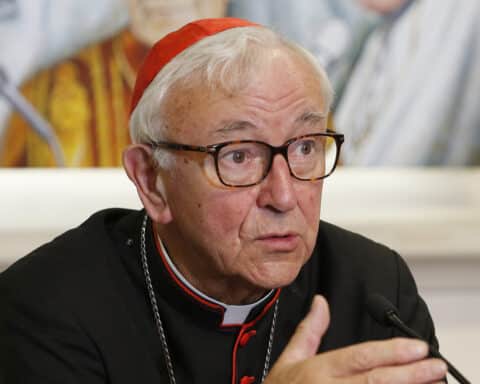(OSV News) — A recently released study from the Institute for Family Studies, a Charlottesville, Virginia-based think tank dedicated to strengthening marriage and family life, reveals that a record number of young adults are predicted to never marry.
The research brief by IFS research fellow Lyman Stone found that based on current marriage data “plausibly, one-third of men and women who turn 45 in 2050 (those who are about 18 or 19 today) will not have married.”
Stone’s research indicates the percentage of never-married adults is at a historic high in the U.S. and because marriage is coming later and later in life, a growing share of Americans will never marry at all.
According to Stone’s figures, 61% of 35-year-old men were ever married in 2023, down from 90% in 1980; 70% of 35-year-old women were ever married in 2023, down from 93% in 1980.
“I think economic factors delaying the life course are the dominant force shaping declining marriage, alongside marriage penalties in tax and welfare policies,” Stone told OSV News. “Overwhelming majorities of young people still report strong desire to marry, and at younger ages than the current median age of marriage.”
Stone said, “The long delay between adulthood and economic independence is the main cause of declining marriage.”
Asked if individualism plays a role, Stone replied that something more fundamental is going on.
“Highly individualistic societies often still have high marriage rates,” he said. “The bigger values shift is about marriage as a ‘capstone’ to personal success rather than marriage as a ‘foundation’ for couple success.”
The best way to deal with these outcomes, Stone said, “is to try and help people get into good marriages earlier in life. There is no societal substitute for marriage.”
Society doesn’t make marriage an incentive
IFS’ collected data is “a rather bleak portrait of where marriage is now, and where it’s heading,” said Julia Dezelski, associate director of marriage and family life at the U.S. Conference of Catholic Bishops’ Secretariat of Laity, Marriage, Family Life, and Youth.
“Unfortunately, I would say I’m not so surprised,” she told OSV News.
Changes in social attitudes have made a major impact upon marriage, Dezelski reflected, citing “the pervasive permissiveness in society towards those things that enable other forms of so-called marital life that’s not officially married. The promiscuity, and the cohabitation, and all the so-called ‘perks’ that come with this kind of lifestyle, obviously does not lend itself to encouraging couples to marry if they can reap the benefits of just cohabiting at a lower cost — and without the risks of pregnancy, thanks to contraception.
“And then, why not delay if IVF would allow them to have children later on, too?” she asked rhetorically, referring to in vitro fertilization. The Church opposes the artificial reproduction method on the grounds that it treats the child as a product, divorces sex from procreation, and the process often involves the destruction of human embryos in order to achieve pregnancy resulting in birth.
“It’s this permissive society in which young people are living,” Dezelski said, “that doesn’t make marriage much of an incentive in the light of all of these other things.”
A beautiful vocation
The Catechism of the Catholic Church notes that marriage as a vocation “is written in the very nature of man and woman as they came from the hand of the Creator.”
But Georgetown University’s Center for Applied Research in the Apostolate notes that in 1965, U.S. Catholic sacramental marriages reported from the previous year numbered 347,179. In 2022, the figure was 98,354.
A 2020 Pew Research Center study of millennials — the generation usually defined as anyone born between 1981 and 1996 — also gave cause for concern, stating, “Millennials are much less likely to be living with a family of their own than previous generations when they were the same age.” Pew found that in 2019, 55% of millennials lived with their spouse, their own child or both, noting, “This compares with 66% of Gen Xers in 2003, 69% of Boomers in 1987 and 85% of members of the Silent Generation in 1968.”
“The church has a huge responsibility here, in trying to paint a picture of marriage as truly the beautiful vocation that it is — and also, just to hearken back to how it fits into God’s plan for salvation,” Dezelski said. The costs of not reversing the nonmarriage trend “are enormous, really — for everyone; for the church, and for society,” she observed. “If we’re not supporting the family, then we will not have families in church to support.”
Parish-level accompaniment
The marriage shift, said J.P. De Gance, founder and president of Communio, a Virginia-based nonprofit ministry that trains and equips churches to renew healthy relationships, marriages, and the family, is nothing short of seismic.
“Too frequently, our Catholic pastors do not see the revolutionary moment that we now live in — or at least if they see it, they’re not altering their pastoral practices given this revolutionary moment,” De Gance told OSV News. “Whatever pastoral steps that we’ve been taking — given where we are in the free-fall of marriage — we didn’t make a change.”
And that conversion, De Gance said, must happen now.
“We need a metanoia,” De Gance declared, referring to the Greek word for a radical reorientation. “I think we have to recognize that parishes are frequently functioning as sacramental service stations.”
Buying into the prevailing social narrative also has endangered marriage, De Gance explained.
“A lot of faithful Christian parents, faithful Catholic parents, will simply repeat what the culture has to say about it — like, ‘You’re too young to get married; why don’t you make sure to get that advanced degree; make sure to land a great job; make sure to have these great life experiences; and then — later on — then you could consider getting married,'” De Gance said. “It’s great to have a great career — of course it is. It’s great to have a good education. But is it more important than the transcendent and enduring things?”
Parish-level accompaniment, De Gance emphasized, is essential.
“My question for every priest, pastor, and bishop is: How much longer do we have to continue to see the annual, year-over-year decline of marriage before we start becoming effective and strategic about actually promoting the vocation of marriage? Eighty-two percent of all Catholic parishes spend zero dollars on marriage ministry each year,” he said. “It may be nice that there’s somebody who’s compensated by the diocese to be the Marriage and Family Life Director — but life change doesn’t happen in a diocesan office.”
Helping newlyweds
A survey by Barna, a Christian research organization, commissioned by Communio found 72% of all American churches lack a substantive marriage ministry, while 74% have no ministry for newlyweds to help them through their first critical years of marriage. Additionally, 93% of churches don’t offer any ministries for singles, which Communio identifies as a “huge opportunity area to encourage healthy habits around dating or finding the right spouse for marriage.”
De Gance spared no words to urge collective responsibility by the Church.
“There are people who will read this article and will nod vigorously. There are priests who will read this article and will nod vigorously. There are bishops who will read this article and will nod vigorously,” he said. “And so I want to ask them a question: ‘What are you currently doing — right now — to promote marriage, and to equip people to discern marriage, and to equip them to live marriage?’ If there aren’t specific answers that they have — and if there’s not a specific amount of money that they’re allocating to that — then they shouldn’t be nodding vigorously.”
De Gance explained that this illustrates how the Church is “part of the problem” — and indicated the Church’s leadership needs to actively address these issues to be part of the solution.
“We’re long past the time for polite concern,” he said. “We’re at a point where marriage is in a three-alarm fire.”





